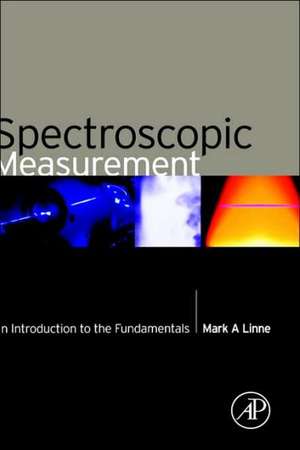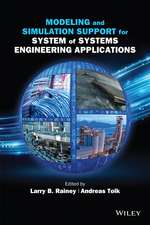Spectroscopic Measurement: An Introduction to the Fundamentals
Autor Mark A. Linneen Limba Engleză Hardback – 28 iul 2002
| Toate formatele și edițiile | Preț | Express |
|---|---|---|
| Paperback (1) | 902.15 lei 5-7 săpt. | |
| ELSEVIER SCIENCE – 12 ian 2024 | 902.15 lei 5-7 săpt. | |
| Hardback (1) | 0.00 lei Indisponibil | |
| ELSEVIER SCIENCE – 28 iul 2002 | 0.00 lei Indisponibil |
Preț: 568.75 lei
Preț vechi: 779.12 lei
-27% Nou
Puncte Express: 853
Preț estimativ în valută:
108.83€ • 116.38$ • 90.74£
108.83€ • 116.38$ • 90.74£
Carte tipărită la comandă
Preluare comenzi: 021 569.72.76
Specificații
ISBN-13: 9780124510715
ISBN-10: 012451071X
Pagini: 268
Dimensiuni: 172 x 244 x 25 mm
Greutate: 0.79 kg
Editura: ELSEVIER SCIENCE
ISBN-10: 012451071X
Pagini: 268
Dimensiuni: 172 x 244 x 25 mm
Greutate: 0.79 kg
Editura: ELSEVIER SCIENCE
Public țintă
Researchers developing new diagnostics or new approaches; Graduate students in areas such as Mechanical Engineering;Senior-level flowfield researchers.
Fields: combustion, reactor studies, plasma processing, atmospheric chemistry.
For teaching in mechanical engineering, physical chemistry, chemical engineering, physics and materials.
Cuprins
Preface Acknowledgments Nomenclature 1 Introduction 1.1 Spectroscopic Techniques 1.2 Overview of the Book 1.3 How to Use This Book 1.4 Concluding Remarks and Warnings2 A Brief Review of Statistical Mechanics 2.1 Introduction 2.2 The Maxwellian Velocity Distribution 2.3 The Boltzmann Energy Distribution 2.4 Molecular Energy Distributions 2.5 Conclusions 3 The Equation of Radiative Transfer 3.1 Introduction 3.2 Some Definitions 3.2.1 Geometric Terms 3.2.2 Spectral Terms 3.2.3 Relationship to Simple Laboratory Measurements 3.3 Development of the ERT 3.4 Implications of the ERT 3.5 Photon Statistics 3.6 Conclusions4 Optical Electromagnetics 4.1 Introduction 4.2 Maxwell's Equations in Vacuum 4.3 Basic Conclusions from Maxwell's Equations 4.4 Material Interactions 4.5 Brief Mention of Nonlinear Effects 4.6 Irradiance 4.7 Conclusions 5 The Lorentz Atom 5.1 Classical Dipole Oscillator 5.2 Wave Propagation Through Transmitting Media 5.3 Dipole Emission 5.3.1 Dipole Emission Formalism 5.3.2 Dipole Radiation Patterns 5.4 Conclusions 6 Classical Hamiltonian Dynamics 6.1 Introduction 6.2 Overview of Hamiltonian Dynamics 6.3 Hamiltonian Dynamics and the Lorentz Atom 6.4 Conclusions7 An Introduction to Quantum Mechanics 7.1 Introduction 7.2 Historical Perspective 7.3 Additional Components of Quantum Mechanics 7.4 Postulates of Quantum Mechanics 7.5 Conclusions 8 Atomic Spectroscopy 8.1 Introduction 8.2 The One-Electron Atom 8.2.1 Definition of V 8.2.2 Approach to the SchrSdinger Equation 8.2.3 Introduction to Selection Rules and Notation 8.2.4 Magnetic Moment 8.2.5 Selection Rules, Degeneracy, and Notation 8.3 Multi-Electron Atoms 8.3.1 Approximation Methods 8.3.2 The Pauli Principle and Spin 8.3.3 The Periodic Table 8.3.4 Angular Momentum Coupling 8.3.5 Selection Rules, Degeneracy, and Notation 8.4 Conclusion 9 Molecular Spectroscopy 9.1 Introduction 9.2 Diatomic Molecules 9.2.1 Approach to the Schr6dinger Equation 9.2.2 Rotation-Vibration Spectra and Corrections to Simple Models 9.2.3 A Review of Ro-Vibrational Molecular Selection Rules 9.2.4 Electronic Transitions 9.2.5 Electronic Spectroscopy 9.2.6 Selection Rules, Degeneracy, and Notation 9.3 Polyatomic Molecules 9.3.1 Symmetry and Point Groups 9.3.2 Rotation of Polyatomic Molecules 9.3.3 Vibrations of Polyatomic Molecules 9.3.4 Electronic Structure 9.4 Conclusions 10 Resonance Response 10.1 Einstein Coefficients 10.1.1 Franck-Condon and HSnl-London factors 10.2 Oscillator Strengths 10.3 Absorption Cross-sections 10.4 Band Oscillator Strengths 10.5 Conclusions 11 Line Broadening 11.1 Introduction 11.2 A Spectral Formalism 11.3 General Description of Optical Spectra 11.4 Homogeneous Broadening 11.5 Inhomogeneous Broadening 11.6 Combined Mechanisms: The Voigt Profile 11.7 Conclusions 12 Polarization 12.1 Introduction 12.2 Polarization of the Resonance Response 12.3 Absorption and Polarization 12.4 Polarized Radiant Emission 12.5 Photons and Polarization 12.6 Conclusions13 Rayleigh and Raman Scattering 13.1 Introduction 13.2 Polarizability 13.3 Classical Molecular Scattering 13.4 Rayleigh Scattering 13.5 Raman Scattering 13.5.1 Raman Flowfield Measurements 13.6 Conclusions 14 The Density Matrix Equations 14.1 Introduction 14.2 Development of the DME 14.3 Interaction with an Electromagnetic Field 14.4 Multiple Levels and Polarization in the DME 14.5 Two-level DME in the Steady-state Limit 14.6 ConclusionsA Units B Constants
Recenzii
"Spectroscopic Measurements: An Introduction to the Fundamentals by Mark A. Linne is the place where you find – and understand – key ingredients of modern combustion diagnostics. For many applications, optical diagnostics play an increasingly important role. However, only the most basic descriptions of the underlying physics are often found in journal articles or textbooks, providing little guidance to the graduate student or the combustion engineer who may wish to familiarize himself or herself with the quantitative aspects and procedures. For this purpose, Linne's book is a top address to review physical principles and necessary equations in a concise and well-organized form. I have used material from this book in an advanced spectroscopy class and found it a valuable complement to textbooks on spectroscopy and reviews on combustion diagnostics. If you are the one to actually perform and evaluate a diagnostics experiment in a complex system like a combustion device, you will appreciate this book as a condensed reference for the related physics machinery – a first-of-its-kind document which guides you through the necessary steps and which spares you to convert formalisms from many different sources." --Katharina Kohse-Höinghaus, Professor of Physical Chemistry, Bielefeld University, Germany











